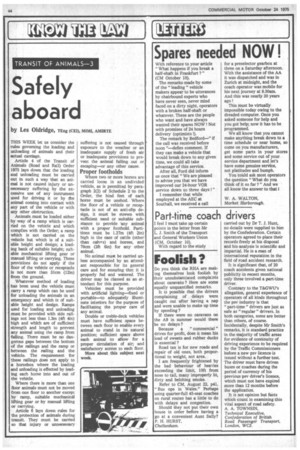Safely aboard
Page 46

If you've noticed an error in this article please click here to report it so we can fix it.
by Les Oldridge, TEng (CEO, MIMI, AMIRTE THIS WEEK let us consider the Tides governing the loading and .ueloading of animals and their actual !carriage.
Artiele 4 of the Transit of Animals (Road and Rale) Other 1975 lays down that the loading and unloading must be carried out in such a way that an animal is not caused injury or unnecessary suffering by the excessive use of any instrument used for driving it or by ale animal coming into contact with any part of the vehicle or with laity other ebetruation.
Animals must be loaded either by way of a ramp which is carried on the vehicle and which complies with the Order; a ramp which is not -carried on the vehidle but which is of a slat'able height and design; a loading bank of suitable height; sir:table mechanical lifting gear or manual lifting or carrying. These previsions do not apply if the floor of the vehicle or receptacle is not more than •31cm (12in) from the ground..
Whatever method of loading has been used the vehicle must carry a ramp Which can be used for unloading the animals tin an emergency and which is of suitable height and design, Ramps used for loading and unloading must be provided With side railings not less than 1.3m (4ft airi) high and Which are of sufficient Strength and length to prevent any animal using the ramp from falling. There must be no dangerous gaps between the bottom of the railings and the ramp or between the mating and the vehicle. The requinement for these railings does not apply to a horsebox where the loading and unloading is effected by leading with horse into and out of the vehicle.
Where there is more than one floor animals must not be moved from one floor to another except by ramp, suitable mechanical lifting gear or by manual lifting or carrying.
Miracle 6 lays down rules for 'the preltection of animals during transit. They must be carried so that injury or unneoesisary suffering is not oaused through exposure to the weather or an inadequate supply of fresh tar or inadequiate provisions to prevent the !animal falling out or escaping—eor 'any other cause.
Proper footholds
Where two or more horses are carried loose in an undivided: vehicle, as is permitted by paragraph 2(2) of Schedule 2 to the: Order, the hind feet of each horse must be unshod. Where the floor of a vehicle or recap-. eade is • not of an ariti-slip design, it must be strewn with, sufficient sand or suitable subStance to provide any animal With a proper foothold. Partertian.s must be 1.27m (4ft 2in) high in the case of cattle (other: than calves) and horses, and. 76am (211t ain) for any other animal.
N:o animal newt be carried unless accompanied by an attendant responsible for its general care and for ensuring th,eit it is properly fed and watered. The driver may be classed as an attendant for this purpose.
Vehicles must be provided with artificial Lighting—fixed or :pcatable—to adequaltely Illuminate inteators for the purpose of facilitating the proper care of any mime!.
Double or treble-deck vehicles must have sufficient space between each floor to enable every animal .to stand in its natural position; sufficient space above each animal to allow for a proper circulation of air; and sededaetory access to each floor.
More about this subject next week.








































































































